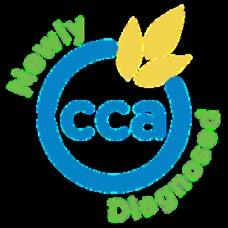CELIACCanadian
Tips to stay safe & gluten free as we gather for the holidays

A MOTHER’S JOURNEY WITH CELIAC DISEASE PLUS

Tips to stay safe & gluten free as we gather for the holidays

A MOTHER’S JOURNEY WITH CELIAC DISEASE PLUS
BOARD OF DIRECTORS
President + Chair: Doris Foster (ON)
President Elect + Vice Chair:
Rumi Jasavala (ON)
Past President: Lizbeth Wall (BC)
Treasurer: Andrew Kotys (ON)
Secretary: Raman Sehmbi (BC)
Eyobe Amberber (ON)
Nancy Dale (ON)
Stu Guttman (QC)
Roberta Kramchynsky (ON)
Don Leslie (BC)
Steven Poirier (ON)
National Executive Director: Melissa Secord, CAE
CONTACT US:
CELIAC CANADA
6733 Mississauga Rd., Suite 700
Mississauga, ON. Canada L5N 6J5
Phone: 905.507.6208 or 800.363.7296
Fax: 905.507.4673 | Email: info@celiac.ca
www.celiac.ca
A MAGAZINE FOR CANADIANS WITH CELIAC DISEASE AND GLUTEN SENSITIVITY
EDITORIAL BOARD
Executive Director: Melissa Secord
Director of Marketing: Lindsay George
Dietitian: Caleigh McAulay
Production Coordinator: Leah Vlasic
Design: Gayle Grin, Art Director www.gaylegrin.design
CONTRIBUTORS
Dr. Richa Chibbar
Ashley Gismondi
Steven Hubley
Sue Jennett
Caleigh McAulay, RD
Jennifer McPherson
Timothy Odette
Miriam Pearl
Melissa Secord
Leah Vlasic
Alyssa Ramuscak
COVER PHOTO BY ZAMRZNUTITONOVI, ISTOCK




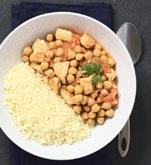
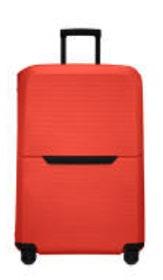

As the days grow shorter and the air turns crisp, the holiday season offers us a time to gather, share, and reflect. For those of us in the celiac community, it can also bring unique challenges — from navigating holiday meals to explaining (again!) why “just a little bit” of gluten isn’t okay. But it’s also a time to celebrate how far we’ve come together.
This issue is packed with ideas to help you make the season joyful, safe, and delicious — from a curated gluten-free gift guide and travel tips, to holiday recipes that are as inviting as they are worry-free. We’re sharing patient stories that remind us why our work matters, mental health strategies for the holidays, and new research updates that move us closer to better diagnosis and treatment.
You’ll also see the incredible ways our partners — like O’Doughs — are helping us amplify awareness and expand resources. Your support fuels this work, whether it’s by attending our webinars, joining our events, or making a gift to keep programs running strong. With Giving Tuesday around the corner, we’re excited to announce a special matching challenge from Promise Gluten Free – doubling the impact of every dollar you give up to $2,000!
As we look ahead to 2026, I’m filled with gratitude for this resilient, inspiring community. Thank you for bringing your passion, your voice, and your generosity to the table. From all of us at Celiac Canada, I wish you a season of warmth, good health, and gluten-free joy.
Warmly,
Melissa Secord Executive Director Celiac Canada


November 15, 2025
Don’t miss this empowering day — your gut will thank you.
Expert-led sessions: learn from top gastroenterologists, dietitians, and researchers.
Real-life strategies: tips on managing symptoms, avoiding gluten, and improving your nutrition.
Community support: shared stories, Q&A, and connection with others who understand your journey.
Accessible and virtual format: join from anywhere!


Throughout grades four, five, and six, it wasn’t unusual to hear our son Ryan say, “Here’s my field trip form, but I’m not going.”
– Jennifer McPherson, Ryan ’s mother
Jennifer McPherson, of Memorial Funeral Home in London, Ontario, shares her family's personal experience with her son’s celiac diagnosis—and how a $5,000 donation from the Arbor Memorial Foundation is helping Celiac Canada support others on their gluten-free journey.
Throughout grades four, five, and six, it wasn’t unusual to hear our son Ryan say, “Here’s my field trip form, but I’m not going.”
He often complained of not feeling well — abdominal cramps, frequent bathroom stops, missing the school bus, and arriving late to hockey games. Ryan was suffering from persistent gastrointestinal symptoms, and we didn’t know why.
We were first referred to a pediatrician who suspected anxiety. Ryan tried various anxiety management techniques, but they didn’t help. Eventually, we were referred to Dr. A. Zizzo, a Pediatric Gastroenterologist at London Health Sciences Centre.
At just 12 years old, Ryan bravely endured a series of blood tests, even counting the vials as they filled. One of the tests measured tissue transglutaminase IgA levels. A few days later, we received a call from Dr. Zizzo’s office: we needed to look at gluten as the possible cause of his symptoms. His test results were so high they couldn’t even provide a number — it was off the charts.
We were advised to keep Ryan on his regular diet until a biopsy could confirm the diagnosis. On November 5, 2019, Ryan underwent the procedure. Dr. Zizzo met me in the waiting room and said she was confident it was celiac disease. Continued on next page

She recommended we start a gluten-free diet immediately.
That moment launched us into a crash course on celiac disease — a serious, lifelong autoimmune condition with no cure.
Suddenly, terms like autoimmune disorder, BROW, cross-contamination, “gluten-friendly”, and the Celiac Canada symbol became
part of our daily vocabulary.
I began reading everything I could and found the Celiac Canada website to be an invaluable resource. It offered clear, educational information that helped our family support Ryan’s transition to a gluten-free lifestyle. We watched webinars like Gluten-Free 101, read monthly newsletters, and joined Celiac Canada

support groups on Facebook. These connections helped us feel less alone and more empowered.
Having Celiac Canada by our side throughout Ryan’s journey inspired me to give back — but I wasn’t sure how.
I work at Memorial Funeral Home in London, Ontario, an Arbor Memorial location, and learned about our company’s donation program. Employees can request funding for charities that matter to their families and communities. I was fortunate to receive $5,000 through the Arbor Memorial Foundation to donate to Celiac Canada—supporting their mission to help find, treat, and one day cure celiac disease.
Ryan is now 18 and has been successfully gluten free for six years. u
Want to support Celiac Canada? If you’re a company interested in partnering or donating, please contact: giving@celiac.ca

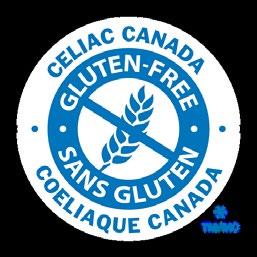
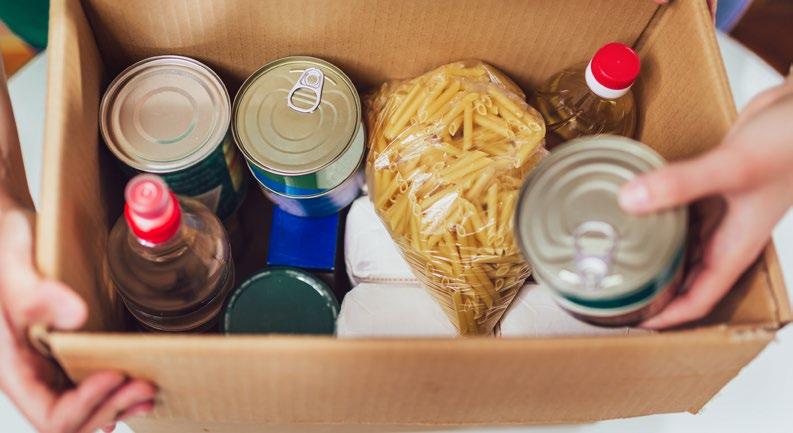
As the holiday season approaches, Canadians are getting ready to celebrate and enjoy great food with their loved ones. People living with celiac disease or other gluten related disorders often approach this season with some trepidation. All the gatherings, events and holiday parties where people come together to enjoy large quantities of gluten-containing food can bring anxiety and fear for those with strict dietary restrictions. Additionally, for those who require a gluten-free diet and rely on food banks, this time of year painfully underscores their struggle to source safe food.
To help members of the celiac community facing food insecurity this holiday season, Celiac Canada is encouraging all Canadians to support the Save Me for Gluten Free program. It’s easy to help – as long as you know how to shop for gluten-free food! Continued on next page

Step 1 Shop for gluten-free items.
Step 2 Bag the items you’re planning to donate.
Step 3 Attach our #SaveMeForGlutenFree seal to the front of the bag.
Step 4 Drop your donation off at your local food bank.
We are proud to recognize O’Doughs as our Save Me for Gluten Free program sponsor. O’Doughs regularly donates gluten-free products to local food banks, and their ongoing support helps ensure that safe, nutritious food reaches those who need it most.
Are you interested in helping this effort? Print off the #SaveMeForGlutenFree labels from our website
There you can also find a list of food banks that provide gluten free food in your area. Let’s help bring gluten-free food to someone in need this holiday season!
Use this list to help fill your bag with gluten-free pantry essentials! Remember to read the labels and ensure everything you’re donating is gluten-free.
1 Baking items (flour, sugar, baking soda and baking powder)
2 Pasta and pasta sauce
3 Canned vegetables and fruit
4 Canned meats and fish
5 Gluten-free oats
6 Meat alternatives (peanut butter, assorted nuts)
7 Canned goods (soups, stews, beans)
8 Rice/Quinoa
9 Milk and milk alternatives (shelf stable milk, powdered milk, almond milk)
10 Seasonings, salt/pepper, cooking oils.
Not to forget: Non-food items such as bathroom tissue, paper towels, toothbrushes, diapers, and personal hygiene products.
Avoid donating:
1 Expired items
2 Items with damaged packaging (i.e. dented or bloated cans, opened packaging)
3 Leftovers
4 Baked goods u

Visit our webpage to learn more about the Save Me for Gluten Free program.


HOLIDAY SURVIVAL
For many, the holiday season is a time of joy, connection, and indulgence. But for those living with celiac disease, it can also bring a heavy mental load — one that’s often invisible to others. From scrutinizing every ingredient to managing social dynamics around food, the pressure to stay safe while still participating fully can be exhausting. The emotional toll of feeling different, missing out on traditions, or constantly advocating for your health can quietly chip away at your holiday spirit.
That’s why it’s so important to prioritize your emotional wellbeing during this time. Whether you’re feeling overwhelmed, isolated, or just in need of a lift, these seven tips are designed to help boost your mood and bring a little more peace and joy to your season. Continued on next page

Practicing mindfulness will help you be in the moment. It’s proven that when we are fully focused on what we are doing and aware of the things going on around us, we are better able to enjoy or handle the things that happen to us.
Try this simple exercise to begin making mindfulness a daily habit: Sit down in an environment that feels good to you. Focus all of your attention on your breath and your sitting body. It is natural for your mind to wander, so kindly just remind yourself to focus on what your body is doing in that moment.

Try to begin your day by listing three to five things you are genuinely grateful for. They can be as simple as the bed you just woke up in, or as detailed as that special something a loved one does for you. Reminding yourself of the wonderful things in your life will help slow your mind and get you off to a positive start each day. Take it to the next level by keeping a gratitude journal by your bed, or in your backpack, purse or car, to note the good things you see or experience throughout your day.

Countless studies have shown that physical activity releases endorphins which help create a positive feeling in the body. Exercise is also associated with a better quality of living and health — which in turn increases your daily mood. Regular activity also increases energy levels, allowing us to feel better about the tasks we take on each day.
What you eat affects your mood. Choosing to eat healthy, natural foods is the baseline for a good lifestyle. It’s also important to eat small snacks regularly, because when blood sugar levels drop, it’s easy for your mood to drop (we’ve all been hangry, right?). If you’re stuck in an unhealthy rut, try a meal plan, including meals that feature favourite veggies and proteins (no need to force yourself to eat foods you hate).
Considering more than half of our bodies are water, it only makes sense that drinking water helps us feel good. Stay hydrated to increase brain power and energy, giving you a better outlook on your days. Experts


recommend drinking around two litres of water per day. If you have a hard time drinking enough, however, consider getting a new reusable water bottle that gets
you excited to drink that H2O. You can also add a squeeze of lemon or lime if you crave a bit of flavour.
Sleep is essential to a good mood. Aim to get at least seven hours of sleep each night, if you can. If you have a hard time falling asleep at night, be sure to turn off your screens an hour before hitting the pillow, and don’t drink caffeinated beverages in the hours before bed.
Whether it’s painting, playing guitar or taking a yoga class, putting time aside for yourself is important. Try to let go of all thoughts centred on your todo list, and focus your mind only on you. In today’s busy lifestyle, it can be hard to fit in personal time, but it’s essential for your well-being. u

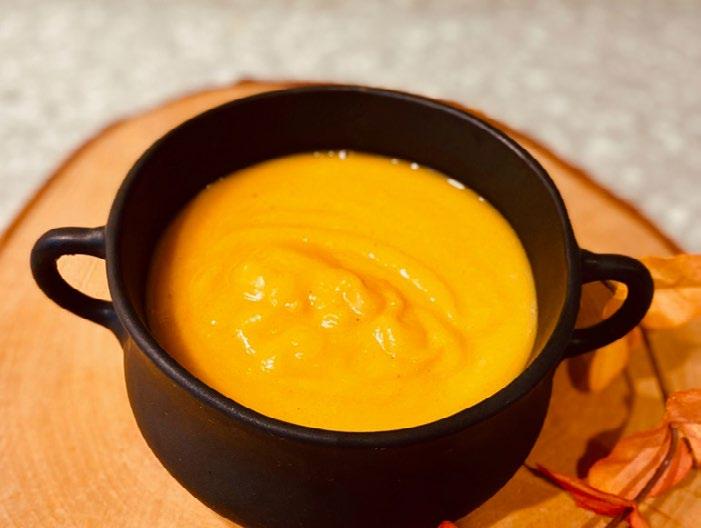
This curry butternut squash soup is creamy, full of flavour and subtly infused with warming curry and coconut milk – a perfect soup for chilly weather. Enjoy it topped with toasted pumpkin seeds!
INGREDIENTS
z 1 tbsp avocado oil
z 2 medium shallots, thinly diced
z 2 cloves garlic, minced
z 6 cups roasted cubed butternut squash (4 lb butternut squash)
z 1 tbsp olive oil
z 1 pinch each salt & black pepper
z 1 ½ tbsp curry powder
z ¼ tsp ground cinnamon
z 1x 400mL can light coconut milk (14oz)
z 3 cups vegetable broth
z 1 tbsp maple syrup
z 2 tsp Red Thai Curry Paste (vegan)
Continued on next page


1 Preheat the oven to 400 degrees Fahrenheit and line a rimmed baking sheet with parchment paper. Place butternut squash (halved vertically and seeds removed) on the pan. Drizzle each half with just enough olive oil to lightly coat the squash on the inside (about ½ tsp each). Rub the oil over the inside of the squash.
2 Turn the squash face down and roast until it is tender and completely cooked, about 45 minutes. Set the squash aside until its cool enough to handle, about 15 minutes.
3 Once cooled, use a large spoon to scoop the butternut squash flesh into a bowl. Set aside.
4 Heat a large pot over medium heat.
5 Once hot, add oil, shallots, and garlic. Sauté for 2 minutes, stirring frequently.
6 Add butternut squash and season with salt, pepper, curry powder, and ground cinnamon. Stir to coat squash. Then cover and cook for 4 minutes, stirring occasionally.
7 Add coconut milk, vegetable broth, maple syrup, and Red Thai Curry Paste.
8 Bring to a low boil over medium heat. Then reduce heat to low, cover, and simmer for 20 minutes.
9 Taste and adjust seasonings, adding more curry powder, salt, or maple syrup as desired. Continue cooking for a few more minutes over medium heat.
10 Use an immersion blender and purée on high until creamy and smooth.
11 This soup can be served hot or cold, as is or with your choice of garnishes. u




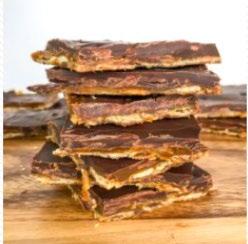

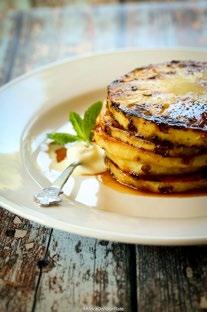

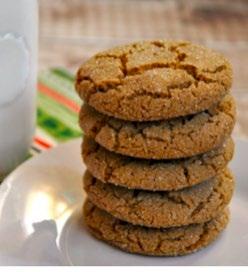




This recipe is a combination of a few different decadent squares. It is sweet, chewy and loaded with flavour. It’s also easy to make and is a real crowd-pleaser.
z 1/2 cup melted butter
z 3 cups gluten-free cereal flakes crushed
z 1 cup shredded coconut
z 1 cup butterscotch chips
z 1 cup chocolate chips
z 1 can sweetened condensed milk
z 1 cup chopped walnuts
INSTRUCTIONS
1 Preheat oven to 325 degrees.
2 Pour melted butter in a 9” x 13” pan, sprinkle crushed cereal over the butter, spread until you get an even layer.
3 Spread the coconut, then chips

over top of the cereal.
4 Carefully pour condensed milk evenly over the pan (pour slowly to get it evenly spread). Sprinkle the walnuts on top.
5 Using the bottom of a measuring cup or glass, press the walnuts into the mixture.
6 Bake approximately 30 minutes until the centre is producing small bubbles. Cool completely at room temperature, cut into squares, a pizza cutter makes this easy.
7 Refrigerate or freeze bars –enjoy. u
Sue Jennett is president of the CCA Kingston Chapter and is a professional baker. Sue is also the voice beyond “A Canadian Celiac Podcast”
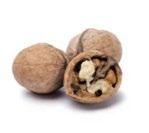














Not all alcohol is safe for people with celiac disease. Here is how to ensure your next drink is gluten free. Manufacturers must state the presence of gluten on the product label, except for beer. It can be declared within the ingredient list, or if no ingredient list is provided, it must be stated within a “Contains” statement.
Distilled alcohols are safe for people with celiac disease. When distilled, the final product does not contain gluten. Types of distilled alcohol include vodka, whiskey, tequila, rum, gin and cognac. (As long as there are no flavourings or additives which need to be assessed separately by reading the label.)
Wine is naturally gluten free and safe for people with celiac disease.
Pre-mixed drinks with vodka or gin are safe, but malt-based mixed drinks are not. Some beverages may also have added flavours. For mixed drinks, it’s important to be cautious and read the label carefully as the gluten-free version can look very similar to the gluten-containing version. Typically, it will state it on the front of the label. As always, when in doubt, go without!
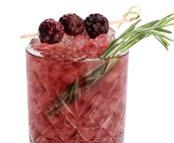
Beer Gluten-free beer is made from gluten-free grain such as millet, sorghum, buckwheat, amaranth, rice or quinoa. When made from a GF grain, these beers are permitted to state ‘GF’ on the label.
Note: Gluten-reduced beers are NOT the same as gluten-free beer. It is important when choosing a beer product to choose one with a gluten-free claim to ensure it is safe for consumption for people with celiac disease. u
Any cocktail can be made a mocktail
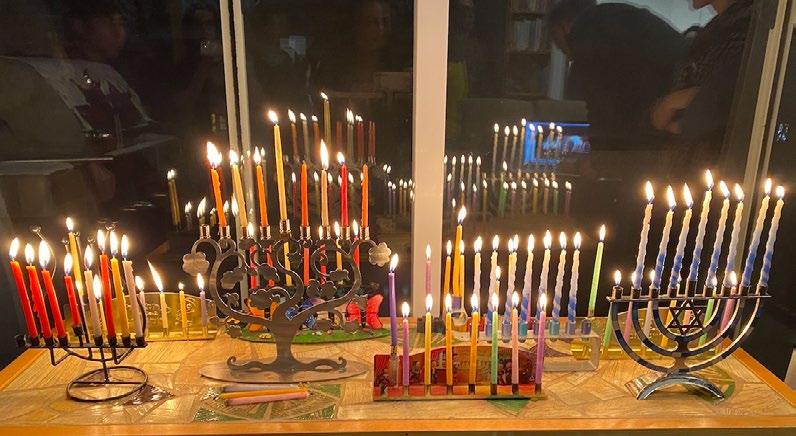
LET’S CELEBRATE!
MIRIAM PEARL Founder and recipe developer, Delicious Without Gluten
Chanukah is the eight-day Jewish wintertime “festival of lights” that is celebrated with a nightly menorah lighting (eight candles), special prayers and fried foods. This year, Chanukah starts on December 14th for eight days. Chanukah is the Hebrew word for “dedication,” and the festival celebrates reclaiming/rededicating the Holy Temple in Jerusalem, 164 BC.
My favorite Jewish holiday is Chanukah, the festival of lights, as many friends and family members gather around and spend time together. I usually host two or three parties during this eight-day holiday when we eat latkas and fried donuts, give presents, light candles and sing songs.
I am a mother of two kids who were both diagnosed with celiac disease at a young age. It was a challenge to adjust to a new way of life, but I always felt lucky that the right food was the best and only medicine they needed. Lucky, as I love spending time in the kitchen. Don’t get me wrong, being gluten free is by no means easy, but it is completely manageable! I learned to have fun and always try to make the best treats I can imagine so my kids never miss out.
Hosting a family gathering is the least of our challenges. In my home, I know my kids can eat safely because I am Continued on next page
BY

the one serving the food. When guests come over, I ask them to bring drinks, fresh fruit, a box of chocolates or flowers. This way, we can ensure the food will be safe for my kids. Our typical dinner includes latkes, (both traditional potato ones and sweet potato latkes), soup, lots of salads, some sushi appetizers, a big salm on and tons of desserts!
Latkes are traditionally made with all-purpose flour but that can easily be replaced with a gluten-free flour.

Hosting a family gathering is the least of our challenges. In my home, I know my kids can eat safely because I am the one serving the food.
Continued on next page
SUPPLIED BY MIRIAM PEARL

Soups, salads and salmon are also easily made gluten free.
Desserts are my favourite and we indulge in many. My favourite dessert is a funnel cake, which we only make at Chanukah. We always make an extra batch of donut batter to place in the fridge. When we want some, we put the contents into a piping bag and squeeze out the dough into a pot of hot oil. They are delicious when topped with powdered sugar. My kids look forward to these treats every year, and the rest of the family does too!
I make many of my family’s favourite cookies and cakes using gluten-free all-purpose flour. For my recipes, I find that gluten-free flour requires more liquid and sometimes a bit more baking powder. They freeze well and are always ready for company!
I wish you all a safe and joyous Chanukah shared with the special people in your life.

Donuts, above, and Miriam’s favourite dessert, funnel cake, right.


There is nothing better than traditional potato latkes made gluten free! My family requests them yearround! Serve with sour cream or applesauce.
Ingredients
z 4 large potatoes (1 kg)
z 1 medium onion (275 g)
z 2 eggs or tofu equivalent
z 1 tsp salt
z 1/2 tsp garlic salt
z 6 tbsp gluten-free all-purpose flour with xanthan gum
z 1 tsp baking powder
Directions
z Peel potatoes and place in cold water.
z Grate potatoes and squeeze out as much water as possible. Dry with towel.
z Grate onion
z Mix all ingredients
z Fry in oiled pan, place on paper towels and enjoy! u
Kwanzaa was created in 1966 as part of the civil rights movement by Maulana Karenga based on the idea that “you must have a cultural revolution before the violent revolution. The cultural revolution gives identity, purpose, and direction.”
Kwanzaa means ‘first fruits’ in Swahili and celebrates seven principles:
1 Umoja: unity in the family, community, nation and all races.
2 Kujichagulia: self-determination, defining, naming, creating and speaking for oneself.
3 Ujima: collective work and responsibility that uplifts your community.
4 Ujamaa: cooperative economics, building our own commerce from which we all profit.
5 Nia: purpose to collectively building community to restore traditional greatness.
6 Kuumba: creativity that leaves our community more beautiful and beneficial for all.
7 Imani: faith from believing with all our hearts in our people, our parents, our teachers, our leaders and the righteousness and victory of our struggle.
Continued on next page

Check out these delicious recipes that are sure to be a party pleaser







Searching for a holiday gift for a friend or family member with celiac disease or gluten intolerance? Need a stocking stuffer for your Secret Santa? Here are some safe gluten-free ideas that we think you will love, for every budget, curated by Toronto’s own Ashley Gismondi (otherwise known as @celiacandthe6ix).
Cuffed Beanie from Celiac Canada Fancy a cozy hat with impact? Shop the Celiac Canada store and support your family and friends with celiac disease while helping them stay warm this winter.
celiac-canada
About $22
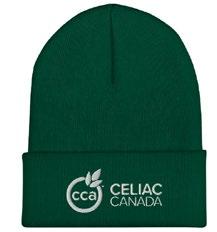
How to Make Anything
Gluten Free by Becky Excell From popular UK gluten-free blogger Becky Excell, this beautiful hardcover cookbook shows you how to unlock all the food you truly miss eating. The perfect gift for someone newly diagnosed; they’ll be a pro at gluten-free cooking and baking in no time!
How-Make-AnythingGluten-Free
About $40
Continued on next page
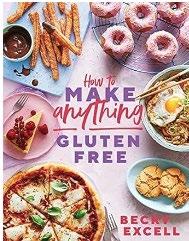


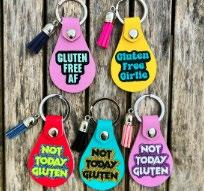
Keychain from Fig & Fortune
The perfect gift for the person who needs to let everyone know they’re “GF” in style. Guaranteed they’ll never lose their keys again with these cute custom keychains. etsy.com/ca/

Baby Baggu Lunch Bag Gluten-free feast mode is activated with Baggu. This miniature version of their reusable shopping bag is perfect for fitting all things gluten free and more with a minimal waste design. baggu.com/collections
About $12
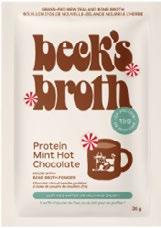
Protein Mint Hot Chocolate by Beck’s Broth Meet this mint under the mistletoe. Hot chocolate takes a cozy twist with refreshing mint but also packs a punch with 15 grams of protein from bone broth to nourish your gut ahead of the holiday season. Might we recommend buying a 12-pack and sharing with your friends and family! shop.becksbroth.com/
About $110 for 12-pack carton or $10 for 1 pack
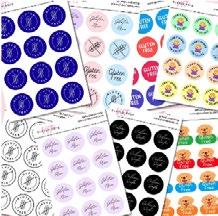
Stickers and labels from The Gluten Free VIP Remember when you would get excited about stickers as a kid? Your gluten-free child or friends will be stoked to get these stylish stickers as a stocking stuffer. These adorable generic or holiday stickers can be used to add flair to cookware, lunchboxes, condiments and more!
glutenfreevip
About $10

Gingerbread Cookie Mix from Stellar Eats
The holidays are what you “bake” of them. This limited-edition grain-free Gingerbread Cookie Mix is one of a kind. It makes perfectly spiced cookies that are crispy on the outside and fudge-y on the inside. Warning: These may get gobbled up before Santa arrives!
stellareats.com
About $13

Goodbye Gluten Gift Box from Baskits Put all your gluten-free goods in one basket for a corporate holiday gift that will wow your colleagues or business partners. In addition to being gluten free, a variety of the products included are also nut free, kosher certified, dairy free, and vegan!
baskits.com/goodbye-gluten Approx $110 u

Ashley Gismondi (@celiacandthe6ix) is a witty “30-something” woman living with celiac disease. @celiacandthe6ix was born out of her love for Drake and is a place where she showcases her gluten-free food finds, travels and musings about motherhood and dating in the “6ix.”
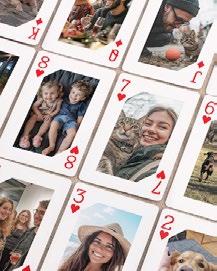
Add a personal touch to bedtime with a custom pillow case featuring their name, favorite quote, or a festive design. Take on the challenge and embroider or paint yourself, or find good options on Etsy.
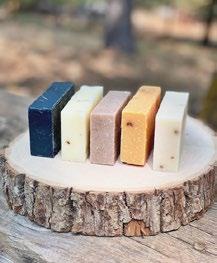
Turn game night into a keepsake with a deck of playing cards printed with cherished photos or inside jokes. You can pair this gift with a custom card holder to complete the thoughtful gift.

Treat someone to a cozy self-care moment with artisanal soaps and bath products made from skin-loving, gluten-free ingredients. While gluten-free labelling can offer extra peace of mind, research shows that gluten is not absorbed through the skin, meaning most cosmetic and personal care products are safe for those with celiac disease. u

SNOWFLAKES + SAFE PLATES
... for those living with celiac disease, travel during this season can be a delicate balancing act between celebration and caution.

The winter holidays sparkle with festive lights, cozy gatherings, and the promise of adventure. But for those living with celiac disease, travel during this season can be a delicate balancing act between celebration and caution. Whether you’re heading to a ski resort, visiting family, or jetting off to a tropical escape, navigating gluten-free living on the go requires thoughtful planning and a dash of holiday spirit.
z Packing peace of mind
Before you zip up your suitcase, take time to prepare your gluten-free essentials. Pack shelf-stable snacks like protein bars, crackers, and instant soups. These can be lifesavers during long flights, layovers, or when safe food options are scarce.
Apps like Find Me Gluten Free and AllergyEats can help you locate restaurants and stores that cater to gluten-free diets. And don’t forget to bring a few travel cards that explain your dietary needs in multiple languages if you’re heading abroad.
z Navigating holiday gatherings
Family dinners and potlucks are a hallmark of the season, but they can be tricky terrain for those with celiac disease. Communicate with hosts ahead of time and offer to bring a gluten-free dish to share. If you’re unsure about cross-contamination, consid er eating beforehand and focusing on the joy of connection rather than the food.

z Ski resorts
Many destinations now offer gluten-free options, but it’s wise to call ahead and confirm. Look for nearby grocery stores or accommodations with kitchenettes so you can prepare your own meals.
z Cabin getaways
If you’re staying in a rental cabin, bring your own cookware and utensils to avoid cross-contamination. Stock up on gluten-free staples before you arrive, especially if you’re heading to a remote location. Continued on next page
Focus on the laughter, the landscapes, and the memories you’re creating, because those are always gluten-free!
z Cruises
Cruise lines are increasingly accommodating to dietary restrictions. Notify them in advance and speak with the dining staff upon arrival to ensure your meals are safe and satisfying.
z Emergency readiness
Travel can be unpredictable, so it’s important to be prepared. Keep a list of nearby hospitals or clinics at your destination, and bring any medications or supplements you may need. Pack extra snacks to ensure you are never without a safe option.
z Celebrate the season, your way
Living with celiac disease doesn’t mean missing out on the magic of the holidays. With preparation and a positive mindset, you can enjoy meaningful experiences, delicious meals, and safe travels. Focus on the laughter, the landscapes, and the memories you’re creating, because those are always gluten-free! u


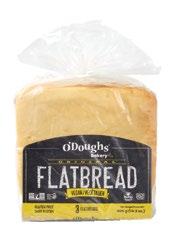
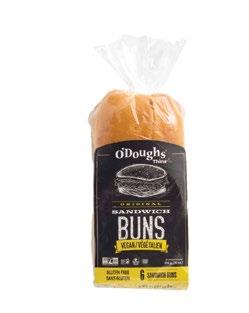



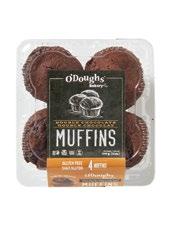
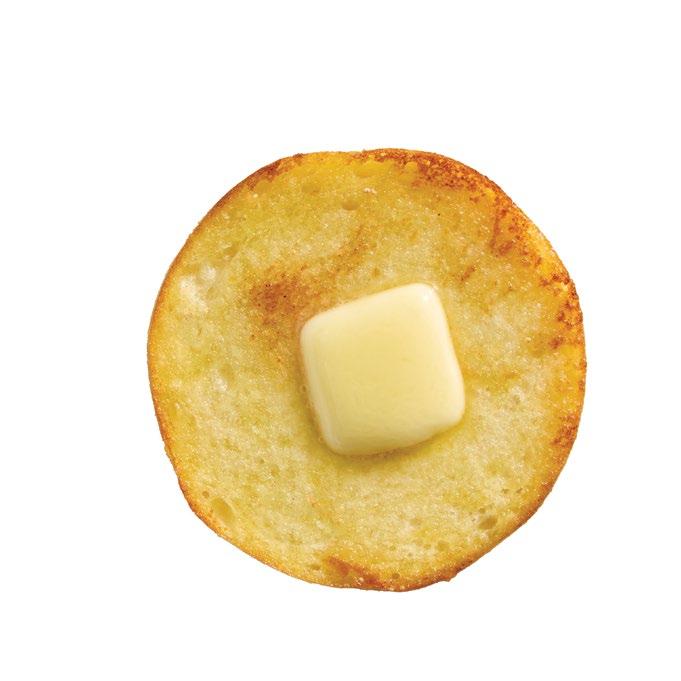



CELIAC CANADA
At Celiac Canada, we’re committed to supporting people with celiac disease at every stage of their journey. From the moment of diagnosis to living well in later years, our programs are designed to provide education, resources, and a sense of community. Here’s an update on some of the programs making an impact this fall:
z Support for newly diagnosed: Newly Diagnosed Pathway
Our Newly Diagnosed Pathway continues to expand, providing essential information kits and digital resources to Canadians newly diagnosed with celiac disease. The program connects individuals with practical tools, educational videos, and dietitian-led guidance so they can confidently transition to the gluten-free diet. We are also increasing our outreach to gastroenterologists and dietitians to ensure more patients are referred early.
z Support for seniors: Aging Well with Celiac Disease
Our pilot program for seniors launched this fall with 100 participants from across Canada. Each

participant received a tailored resource kit and will take part in webinars, peer-to-peer support, and ongoing education designed to help them age well with celiac disease. Due to overwhelming demand, we already have a waitlist for the next round and are actively seeking funding to expand the program.
z Specialty and monthly Gluten-Free 101 webinars
Celiac Canada continues to host
monthly Gluten-Free 101 webinars for those who are newly diagnosed, as well as specialty sessions on topics like mental health, travel, the gut microbiome, and more. These live, interactive webinars reach hundreds of participants across Canada, offering expert advice and a sense of community. With the help of sponsors and dedicated speakers, we’re able to provide these programs free of charge to anyone who needs them. u
CELIAC DISEASE + INFLAMMATORY BOWEL DISEASE
Celiac disease and inflammatory bowel disease share more than just symptoms — research shows a strong link between the two, making awareness and early diagnosis essential for effective management

In fact, people diagnosed with celiac disease are at higher risk of being diagnosed with inflammatory bowel disease.
If you’ve been diagnosed with celiac disease or inflammatory bowel disease, it’s important to know that having one autoimmune condition may increase your risk of developing another.1,2 In fact, people diagnosed with celiac disease are at a higher risk of being diagnosed with inflammatory bowel disease. 2 Here’s what that means and what to watch for.
Celiac disease and inflammatory bowel disease; similar, but different Celiac disease and inflammatory bowel disease are both autoimmune conditions that affect the digestive tract and cause inflammation. However, they differ in what triggers them and where they occur in the gut.
In celiac disease, eating gluten, a protein found in wheat, barley, rye, and cross-hybrids like triticale, can trigger the immune system to attack the lining of the small intestine, causing inflammation and damage.3,4 Over time, this can lead to nutrient deficiencies and a wide range of symptoms.3,4
In contrast, inflammatory bowel disease refers to chronic inflammation of the gastrointestinal tract, mainly involving two conditions: Crohn’s disease and ulcerative colitis.5 These conditions are characterized by an immune system response that mistakenly attacks healthy cells in the bowel.5 Crohn’s disease can affect any part of the digestive tract, but often impacts the end of the small intestine and beginning of the large intestine or colon.5 Ulcerative colitis typically affects the large intestine only, starting from the rectum and extending into the large intestine.5 Unlike celiac disease, the trigger or specific cause of inflammatory bowel diseases are unknown.2,5,6
QUICK COMPARISON: CELIAC DISEASE VS. INFLAMMATORY BOWEL DISEASE 7
Feature
Location in the gut
Trigger
Onset
Symptom pattern
Celiac disease
Affects the innermost lining of the small intestinal wall
Gluten
Can appear at any age
Presents with many different signs and symptoms depending on how sensitive someone is to gluten and the amount of gluten they eat
Inflammatory bowel disease
Affects the innermost lining of the intestinal wall, commonly in the large intestine
Unknown
Often diagnosed in teens or early adulthood
Presents with many different signs and symptoms depending on the location in the digestive tract and the severity. Often cyclic, with periods of flare-ups (relapse) and no symptoms (remission)
Continued on next page
While both conditions affect the gut, they do so in different ways. When they occur together, symptoms can overlap or become more severe.
INFLAMMATORY BOWEL DISEASE
The affected segments often interspersed with unaffected ones Healthy segment










The inflammatory process spreads upward from the rectum Inflammation is limited to the mucosal lining
















CELIAC DISEASE Crohn’s disease


Inflammation (can affect all layers of the intestinal wall)











While both conditions affect the gut, they do so in different ways. When they occur together, symptoms can overlap or become more severe.1,2 It can make diagnosis and management more complex.
How common is celiac disease and inflammatory bowel disease?
In a systematic literature review and meta-analysis of 65 studies, researchers found that there was almost a 9-fold increased risk of inflammatory bowel disease in patients with celiac disease compared to control groups (e.g., healthy patients).2 Specifically, there appeared to be a higher risk for Crohn’s disease.2
Early detection of overlapping conditions can make a big difference in managing your long-term health.
Interestingly, the link appears to go both ways; people with inflammatory bowel disease may also be at a higher risk for celiac disease, with the researchers in the study finding an almost four-fold increased risk compared to control groups.2
There are several reasons why celiac disease and inflammatory bowel disease may be so strongly linked. Researchers believe these conditions may share a complex interplay of risk factors, including genetics, immune system responses, and environmental triggers.2 ,7-9 For example, certain genes increase the risk of both conditions. In genome-wide studies, overlapping genetic markers have been observed, especially between celiac disease and Crohn’s disease.8,9
Similarly, both diseases have been characterized as having similar inflammatory pathways, including increased intestinal permeability, impaired T-cell activity, and proinflammatory cytokines, molecules that trigger and intensify inflammation.2 Lastly, environmental factors that may change the gut microbiota have also been studied.10
When to suspect that it may be more than celiac disease
If you have been following a strict gluten-free diet but are still experiencing symptoms such as ongoing diarrhea, rectal bleeding, weight loss, and symptoms outside the digestive tract such as joint pains or skin rashes, it may not just be celiac disease.7,11
People with both celiac disease and inflammatory bowel disease tend to have higher serology levels and more severe intestinal damage, which may make it harder to improve.1 If you suspect that it may be more than just celiac disease, it is important to follow-up with your gastroenterologist to rule out other conditions like inflammatory bowel disease.11 Continued on next page

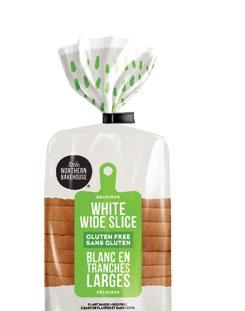

If you have inflammatory bowel disease and suspect you may have celiac disease, diagnosis can be tricky.
Testing while still eating gluten is important to receive a celiac disease diagnosis.
Routine bloodwork and monitoring by a physician is also essential when diagnosed with both conditions, to prevent complications such as liver disease or even certain cancers.11
A note for people with inflammatory bowel disease who suspect celiac disease
If you have inflammatory bowel disease and suspect you may have celiac disease, diagnosis can be tricky. That’s because biologics or immuno-
suppressant medications that are used to manage and reduce inflammation, can interfere with celiac blood tests and lead to a false negative serological result.12 In addition, a gluten-free diet has been associated with symptom improvement in inflammatory bowel disease, which can further delay proper celiac disease testing and diagnosis.13
Always speak with your healthcare provider before starting a gluten-free diet. Testing while still eating gluten is important to receive a celiac disease diagnosis.
If you are not feeling better despite following your treatment plan, it might be time to speak with your healthcare team. Early detection of overlapping conditions can make a big difference in managing your long-term health. u

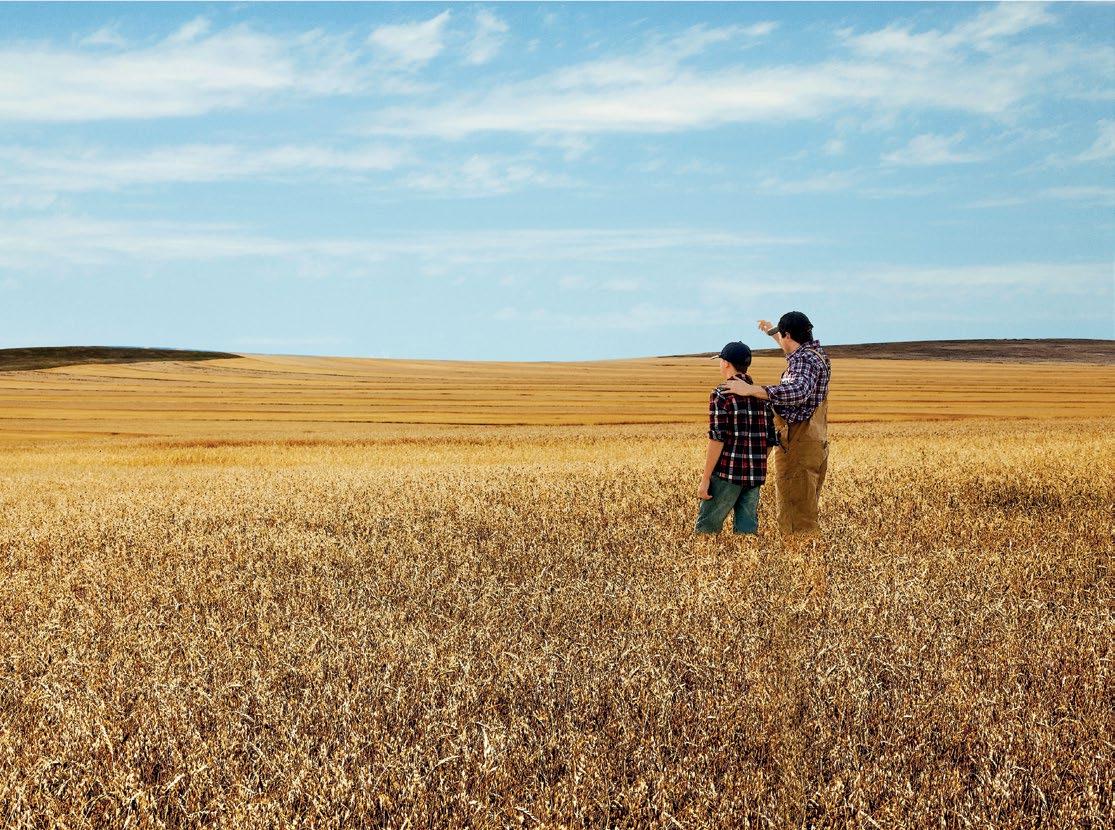

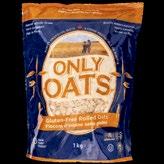


Routine
bloodwork and monitoring by a physician is also essential when diagnosed with both conditions, to prevent complications.
1 Markley A, Rendon L, Diola C, Israel Y, Waite H, Green P, et al. S2257 Celiac Disease and Inflammatory Bowel Disease: Characteristics of a Dual Diagnosis. American Journal of Gastroenterology. 2024 Oct;119(10S):S1610–2.
2 Pinto-Sanchez MI, Seiler CL, Santesso N, Alaedini A, Semrad C, Lee AR, et al. Association Between Inflammatory Bowel Diseases and Celiac Disease: A Systematic Review and Meta-Analysis. Gastroenterology. 2020 Sep;159(3):884-903.e31.
3 Daley SF, Haseeb M. Celiac Disease. 2025.
4 Hill ID, Fasano A, Guandalini S, Hoffenberg E, Levy J, Reilly N, et al. NASPGHAN clinical report on the diagnosis and treatment of gluten-related disorders. J Pediatr Gastroenterol Nutr. 2016 Jul 1;63(1):156–65.
5 McDowell C, Farooq U, Haseeb M. Inflammatory Bowel Disease. 2025.
6 Markley A, Rendon L, Patel S, Israel Y, Diola C, Green P, et al. S2258 The Effect of Concomitant Inflammatory Bowel Disease on Patients With Celiac Disease. American Journal of Gastroenterology. 2024 Oct;119(10S):S1612–3.
7 Pascual V. Inflammatory bowel disease and celiac disease: Overlaps and differences. World J Gastroenterol. 2014;20(17):4846.
8 Oxford EC, Nguyen DD, Sauk J, Korzenik JR, Yajnik V, Friedman S, et al. Impact of Coexistent Celiac Disease on Phenotype and Natural History of Inflammatory Bowel Diseases. American Journal of Gastroenterology. 2013 Jul;108(7):1123–9.
9 Tse CS, Deepak P, De La Fuente J, Bledsoe AC, Larson JJ, Murray JA, et al. Phenotype and Clinical Course of Inflammatory Bowel Disease With Co-existent Celiac Disease. J Crohns Colitis. 2018 Jul 30;12(8):973–80.
10 Caminero A, Meisel M, Jabri B, Verdu EF. Mechanisms by which gut microorganisms influence food sensitivities. Nat Rev Gastroenterol Hepatol. 2019 Jan 13;16(1):7–18.
11 Lodhi MU, Stammann T, Kuzel AR, Syed IA, Ishtiaq R, Rahim M. Celiac Disease and Concomitant Conditions: A Case-based Review. Cureus. 2018 Feb 2;
12 Rashid M, Lee J. Serologic testing in celiac disease: Practical guide for clinicians. Can Fam Physician. 2016 Jan;62(1):38–43.
13 Weaver KN, Herfarth H. Gluten-Free Diet in IBD: Time for a Recommendation? Mol Nutr Food Res. 2021 Mar 28;65(5).

Have your voice heard! Our e-petition to change tax laws requires us all to lean in. From the outset, we knew that changing federal income tax laws would require significant time and resources. It is a continuous effort to ensure that the burden of the gluten-free diet on Canadians with celiac disease is recognized as an important policy issue that can lead to improved long-term health outcomes.
Our Federal Advocacy Working Group is actively identifying strategies to advance our cause, including collaborating with Coeliaque Quebec in solidarity. Led by Roberta Kramchynsky, our working group has created an electronic petition that will be presented to the Government of Canada. This petition aims to raise awareness about our request to change the current non-refundable incremental tax claim for gluten-free food to a flat, refundable tax credit, providing meaningful relief to families affected by celiac disease.
As we navigate uncertain political times with a minority government, the timing of our petition is critical. We must raise awareness of our issue with all political parties.
Our goal is to gather 30,000 signatures by the deadline of December 6, 2025, at 3:47 PM ET.
1.Sign the Petition
Take one minute to follow the link below and provide your first and last name, email address, phone number, province, and postal code. Please note that only Canadian citizens can complete the petition. Ensure to verify your signature via email—check your junk folder! Click here to sign the petition.

2.Please Donate
If you can make a special contribution this year to support our legislative efforts, we would be incredibly grateful for your generosity. Donate today!

